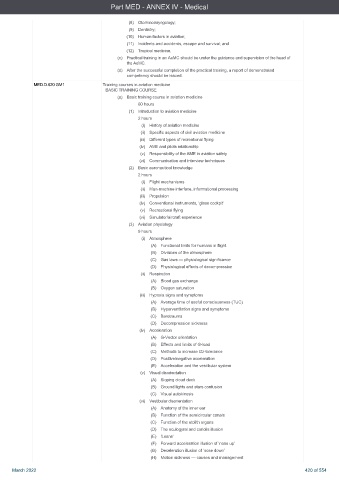Page 420 - UK AirCrew Regulations (Consolidated) March 2022
P. 420
Part MED - ANNEX IV - Medical
(8) Otorhinolaryngology;
(9) Dentistry;
(10) Human factors in aviation;
(11) Incidents and accidents, escape and survival; and
(12) Tropical medicine.
(c) Practical training in an AeMC should be under the guidance and supervision of the head of
the AeMC.
(d) After the successful completion of the practical training, a report of demonstrated
competency should be issued.
MED.D.020 GM1 Training courses in aviation medicine
BASIC TRAINING COURSE
(a) Basic training course in aviation medicine
60 hours
(1) Introduction to aviation medicine
2 hours
(i) History of aviation medicine
(ii) Specific aspects of civil aviation medicine
(iii) Different types of recreational flying
(iv) AME and pilots relationship
(v) Responsibility of the AME in aviation safety
(vi) Communication and interview techniques
(2) Basic aeronautical knowledge
2 hours
(i) Flight mechanisms
(ii) Man-machine interface, informational processing
(iii) Propulsion
(iv) Conventional instruments, ‘glass cockpit’
(v) Recreational flying
(vi) Simulator/aircraft experience
(3) Aviation physiology
9 hours
(i) Atmosphere
(A) Functional limits for humans in flight
(B) Divisions of the atmosphere
(C) Gas laws — physiological significance
(D) Physiological effects of decompression
(ii) Respiration
(A) Blood gas exchange
(B) Oxygen saturation
(iii) Hypoxia signs and symptoms
(A) Average time of useful consciousness (TUC)
(B) Hyperventilation signs and symptoms
(C) Barotrauma
(D) Decompression sickness
(iv) Acceleration
(A) G-Vector orientation
(B) Effects and limits of G-load
(C) Methods to increase Gz-tolerance
(D) Positive/negative acceleration
(E) Acceleration and the vestibular system
(v) Visual disorientation
(A) Sloping cloud deck
(B) Ground lights and stars confusion
(C) Visual autokinesis
(vi) Vestibular disorientation
(A) Anatomy of the inner ear
(B) Function of the semicircular canals
(C) Function of the otolith organs
(D) The oculogyral and coriolis illusion
(E) ‘Leans’
(F) Forward acceleration illusion of ‘nose up’
(G) Deceleration illusion of ‘nose down’
(H) Motion sickness — causes and management
March 2022 420 of 554

